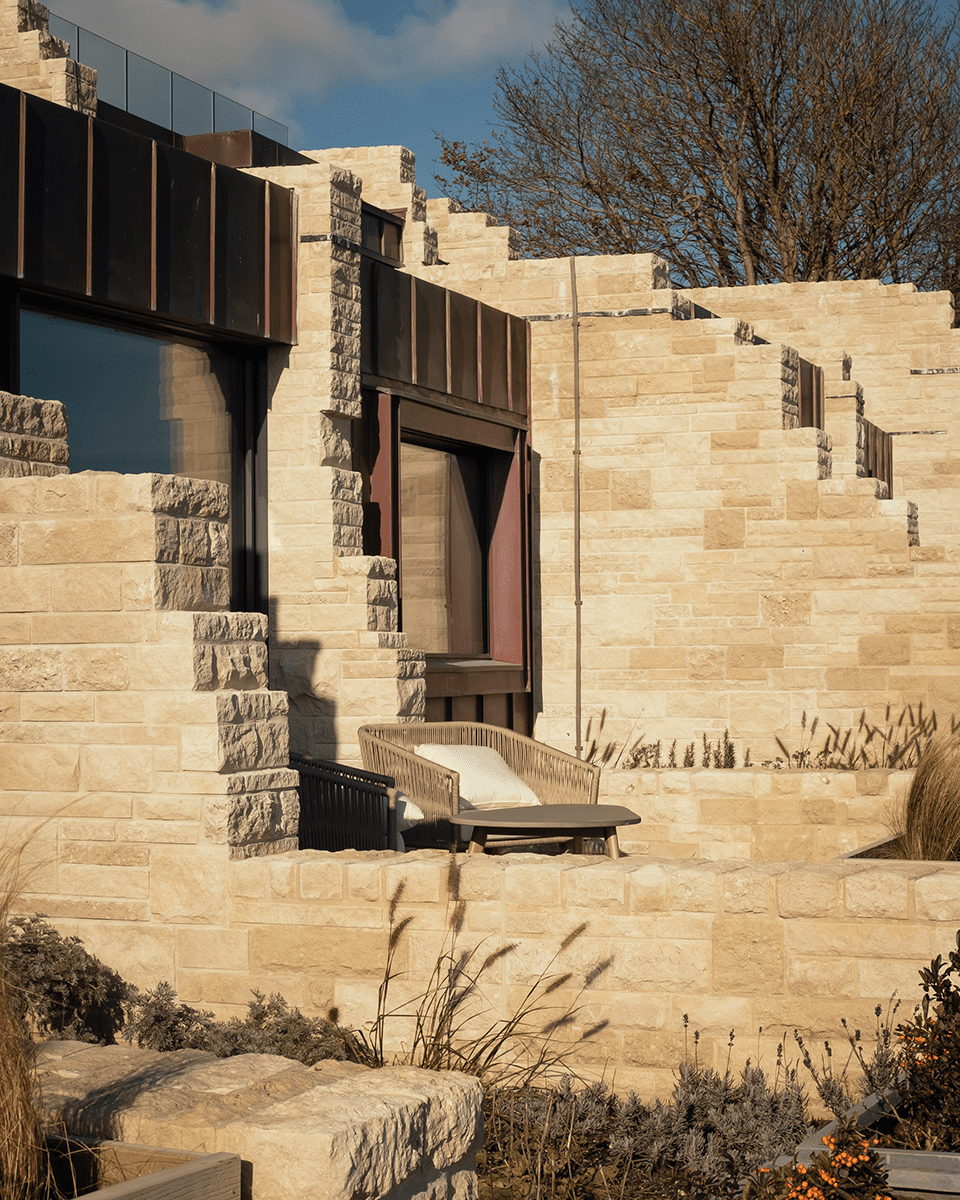Caroline Hall from Natural Stone Projects answers readers’questions on stone.
Clifftops, a cluster of holiday lodges designed by Morrow + Lorraine for the Pennsylvania Castle Estate in Dorset, is set into the rugged cliff by large, rough-cleaved blocks of Albion stone. Cut from the local Portland Quarries, the stone yields a low carbon footprint, is long lasting and anchors the architecture to its locale.
How do I know if the stone selected will be suitable for purpose?
Ask your supplier to check that the values declared on the Declaration of Performance and CE certificate address the specific requirements of the project. Additional tests can be arranged at an accredited laboratory. Examples include a salt resistance test for a coastal project, a test for any change in appearance over cyclical wet and dry conditions for swimming pools, and slip resistance with the specified finish. Tests can take around six weeks so they are worth considering well in advance. The CE standards are due to be changed to UKCA (UK Conformity Assessed) following Brexit but it looks like this will be at least two years away.
I have small sample which I like. How do I check any potential variation in appearance?
Take heed – your small sample is not a reference sample! As a first step, ask your supplier for known variations on tonality or unusual marks that may appear on a larger format or over a larger quantity. Secondly, do ensure your client has realistic expectations and order extra or pay more for selection if you want to avoid or include certain marking. For cut-to-size jobs, a render image can be produced for the client to approve to show how the slab will be cut and look in situ. Slabs can be inspected in person or by video call.
For larger projects, you can invest in 10 large reference samples which represent the full range of marking and tonality for the current yield, to be viewed at eye level from a suggested distance of 2 metres with photos recorded. Where selection is critical or there is a complex layout, a dry lay (possibly by drone) allows a dress rehearsal. For major projects, mock ups will determine the final selection stage.
How can we achieve best value with stone?
Large format tiles are very popular but will be at a premium as they can result in a higher level of waste and require careful selection of blocks to ensure consistent quality. Random lengths at standard widths will offer the best value as they can use the slabs most efficiently. Beyond this, the standard sizes such as 600×600 mm and smaller sizes such as 600×400 mm will offer the best value. There will usually be a choice of close alternative stones that can suit a range of budgets. Wherever possible, order from one quarry or one country of origin to achieve best value with freight.
Can I match an existing stone?
Matching an existing stone will never be perfect as each batch will vary and the existing stone will have aged but we can source the stone and check current yield or find a close look-a-like.
How sustainable is natural stone compared to imitation stone porcelain products?
In recent years the “stone effect” market has boomed, with prints of popular natural stones being applied to porcelain and ceramic. They lack the texture, unique identity and thermal qualities of natural stone but most importantly when comparing materials in relation to highly loaded floors, natural stone is also shown to have a significantly lower CO2 equivalent when compared to terrazzo and ceramic tiles. The ecological life cycle impact of natural stone is also 74% lower than that of ceramic tiles.
How does natural stone affect a building’s whole-life-carbon impact?
Britain’s major cities have been architecturally defined by natural stone buildings that have stood the test of time. The whole-life-carbon impact of a building includes material extraction or creation and transport as well as lifetime emissions from maintenance, repair, replacement and disposal of the materials. For architects looking to specify materials that minimise carbon impact, natural stone is a fantastic choice, delivering sustainability in both its extraction and whole-life value. In the Green Guide to Specification, which is part of BREEAM, almost half of all natural stone related components achieve either A+ or A and the majority of the remainder score a C or above.
How can I find the right stone for the project?
The combination of aesthetics, performance and budget can be a challenge. At Natural Stone Projects, we source stone from the UK and all over the world. We listen to the brief and offer a wide range of samples to consider. Recent global commercial projects specified materials as diverse as super-size split-face Roman Travertine, English Ironstone, textured white limestone cladding and Alpine Green quartzite paving.
For further information or samples contact Caroline Hall at Natural Stone Projects www.stone-projects.com; 020 8943 3221; caroline@stone-projects.com

















